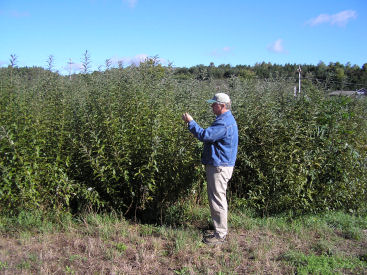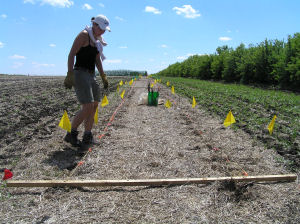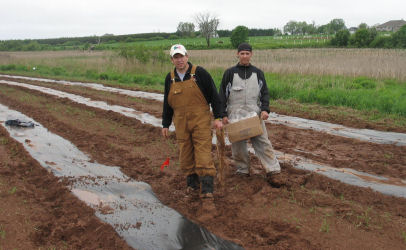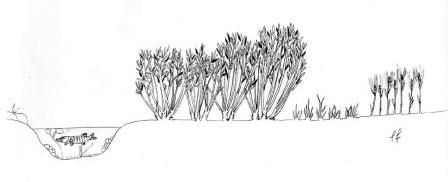Planting fast-growing native willows for biomass production could increase the diversity, profits and viability of farms across Canada, experts say. "Biomass has the potential to make a significant contribution to energy supplies, both nationally and worldwide," says Bill Schroeder, head of research at Agriculture and Agri-Food Canada - Prairie Farm Rehabilitation Administration (AAFC-PFRA) Agroforestry Division's Shelterbelt Centre at Indian Head, Saskatchewan. The AAFC-PFRA Agroforestry Division is partnering in a three-year research project to study short-rotation willow plantations and agroforestry systems for biomass and bioenergy generation. "Our goal is to create agroforestry knowledge for practical use by producers and land managers, so they can manage their land resource sustainably while also benefiting from the production of biomass and its energy potential," says Schroeder.
 |
Bill Schroeder, AAFC-PFRA researcher, evaluates re-sprouting on harvested willow. (Photo courtesy of AAFC-PFRA) |
| AAFC-PFRA technician inspects alley-cropping site. (Photo courtesy of AAFC-PFRA) |  |
Biomass is any renewable organic matter such as trees, crops, feeds or agricultural residues, and can be used to reduce greenhouse gas emissions and produce energy for final end uses such as heat, fuel and electricity. Historically, biomass commodities (such as wood) were the main source of heat for many Canadian homes, farms and businesses. "New conversion technologies are resulting in renewed interest in biomass production for energy. This process is capable of generating both sustainable energy and environmental benefits"it's a two-for-one deal," says John Kort, a researcher with the AAFC-PFRA Agroforestry Division.
 |
AAFC technicians at biomass riparian planting. (Photo courtesy of AAFC-PFRA) |
Funded by the Technology and Innovation fund of the Canadian Biomass Innovation Network, the agroforestry biomass project consists of two sub-projects with study sites in Saskatchewan, ontario, Quebec and Prince Edward Island. The sub-projects are: agroforestry systems for energy production and native willows for biomass production.
 |
Schematic for Willow Alley-Cropping Biomass. (Schematic courtesy of AAFC-PFRA) |
Under the agroforestry systems sub-project, AAFC-PFRA Agroforestry Division researchers are evaluating willow alley-cropping and riparian buffers. At the alley-cropping sites, they are studying willow interactions with herbaceous biomass crops to see if improved moisture availability and other microclimate effects increase total biomass production compared to monocultures while reducing net carbon emissions. The riparian study sites will test the hypothesis that willow-based riparian buffers provide high biomass yields while providing environmental benefits (that is, erosion reduction, nutrient interception, and improved soil and water quality). Willows are ideally suited for riparian buffers because they are naturally found in riparian zones and they have the ability to readily develop an extensive root system which forms an effective biofilter and soil stabilizer.
 |
Schematic for Riparian Buffer for Biomass. (Schematic courtesy of AAFC-PFRA) |
Furthermore, the economic feasibility of willow biomass and conversion technologies are being studied by researchers with Natural Resources Canada (NRCAN). As part of the willow sub-project, NRCAN is selecting native willows from across Canada, with the intent to choose species and clones that can be further developed for biomass production through breeding and/or selection. Its goal is to find willows that grow faster and produce more biomass. "Willow has a very high biomass production potential; its energy value per dry tonne is similar to other hardwoods," says Kort. "Furthermore, it easily establishes with unrooted cuttings and re-sprouts vigorously after harvest."
These projects will identify what biomass production advantages agroforestry systems have compared with herbaceous (grass/forages) or woody monocultures (poplar farming). In this project, AAFC-PFRA Agroforestry Division researchers are working in partnership with: University of Saskatchewan, Indian Head Agricultural Research Foundation, University of Guelph, Insitut de technologie agroalimentaire, Canadian Forest Service (Fredericton, Ste-Foy and Edmonton), Prince Edward Island Soil and Crop Improvement, Jardin Botanique de Montreal and the Saskatchewan Research Council.
For additional information, contact Bill Schroeder, AAFC-PFRA Agroforestry Division, Indian Head, SK CANADA
Ph: 1.306.695.2284; email: This email address is being protected from spambots. You need JavaScript enabled to view it..
By Sarah Seinen



